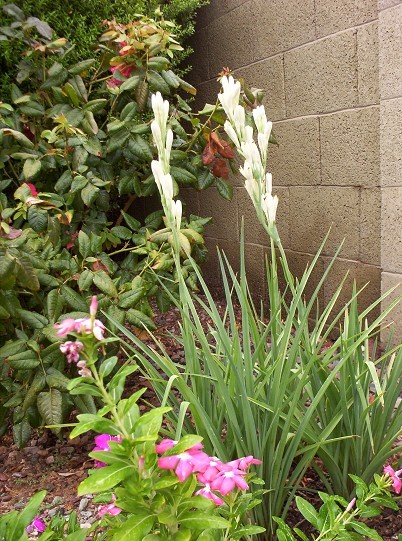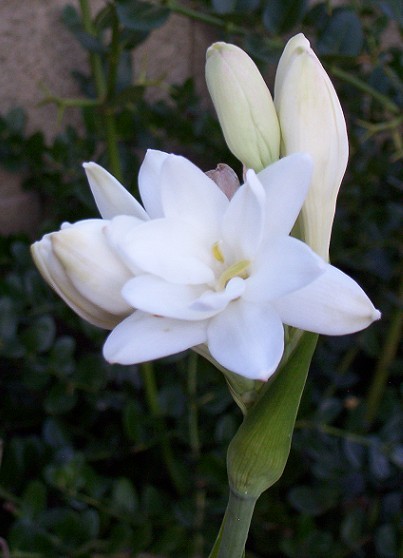|
 Photo
Photo
The tuberose has white flowers and grass like leaves and stems. Several tuberoses are
shown in the picture on the right in August.
They were planted in early May as bulbs on the east side of a six foot wall,
so they receive direct sunshine until noon and shade in the afternoon.
Overview
Tuberoses are easy to grow in Phoenix Arizona. They handle the summer heat well
when given enough water, and go dormant in the winter so there is no need to worry
about them freezing. The only way a tuberose could be damaged by the cold
is for the ground to freeze down to the level of its dormant bulb which never happens
in the lower desert.
The fragrance these flowers produce is sweet,
strong, and similar to that of a gardenia. During hotter weather, the flowers open more at night
but can still be smelled during the day. Tuberose is often used for leis in Hawaii
being even more aromatic than plumerias.
Heat Tolerance and Sun Exposure
Tuberose takes the Phoenix summer heat very well and
grows rapidly. The flowers
don't take the dry heat quite as well as the plant and tend to dry up before opening during
the hottest driest times of the year. During milder months, like in September, be
prepared to smell their sweet fragrance wafting through your garden. The photo below
shows a very unusual blooming of a tuberose in late January of 2009, which had been
an unusually warm month with temperatures often reaching into the upper 70's F.
Cold Tolerance
Tuberose is a bulb flower so it goes dormant in the winter and dies back. It will regrow from its
roots when the weather warms up again. The only way the bulb can be damaged is if the ground freezes
solid over 6 inches deep, which never happens in Phoenix.
 Planting
Planting
Dig a hole a little bit larger than the size of the bulb.
Work in a 50/50 mix of compost to soil in the backfill,
and bury the bulb several inches below its tip with the pointed end facing upward.
It also is a good idea to finish with the
hole an inch or two recessed so that a watering basin is formed.
Watering method
A basin irrigation method is preferable to ensure
the plants get a good soaking every time they are watered.
Watering frequency
Tuberose do well on a grass watering schedule during the summer.
Very little water is needed in winter when the plant is dormant.
Fertilizing and Growth Rate
I occasionally fertilize with 5-1-1 and 0-10-10 fish emulsion. Chemical fertilizers might
also work for tuberoses, but make sure to start with very small amounts to see if they get burned.
Propagation
Bulbs can be separated from the main root mass and planted elsewhere.
Pests
Tuberose has no significant pest problems in Arizona.
Links to more tuberose information
Tuberose in Wikipedia
Single Mexican Tuberose
|
 Book the Phoenix Tropicals Condo on Kiahuna Beach, in Kauai, Hawaii
Book the Phoenix Tropicals Condo on Kiahuna Beach, in Kauai, Hawaii